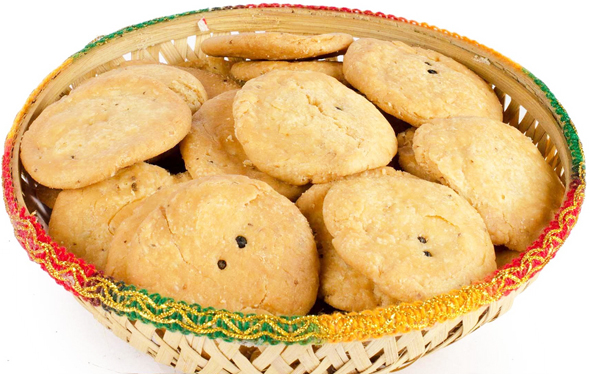Mama’s Punjabi Recipes: Punjabi Mitthi Matthi (Punjabi Sweet Fried Crackers)
The biscit wallah’s (snack confectioner) shop in the West Delhi enclave of Shiv Nagar is always jam packed with so many types of biscuits and snacks – mostly fried ones – that it is hard to leave without being tempted to buy small amounts of a variety of them. Unlike what we would find here, most of these are salted snacks, like papad (flat wafers); phul wadiyan (ready-to-fry dried dumplings); sewiyaan (thin fried chickpea flour sticks) and namak parre (fried flour wafer squares), though there are packets of biscuits too, from a bakery.
But the snacks that are most obvious are the matthis or fried crackers in huge jute cloth-lined wicker baskets, straight from the large kadai (cauldron) that is in the room next-door, where the cooks prepare them every day. There are super large thin ones with a little salt; the medium thick plain ones and those with ajwain (carom seeds) or jeera (cumin seeds) or kali mirch (black peppercorns) and one even folded in a triangle. And on a shelf, in a packet are the mitthi matthi (sweet fried crackers) for those who like them sweet!
Salty matthis are more in demand during the winter months when people will eat them over hot tea, sitting in the sun with a saunf (fennel seed), mustard oil and spices masala from the amb da achar (green mango pickle) jar or with mittha achar (sweet and sour vegetable pickle). But, for the evening or morning tea, the sweet variety is more popular!
Sweet matthis can easily be made at home out of wheat flour and a little maida (self-rising flour). The recipe is quite similar to the salty one, with the difference being in the way the sweetener is added. Because no baking powder is used, it is important to keep the dough medium hard otherwise the matthis will be wet inside and spoil quickly.
Ingredients :
2 cups atta (whole wheat flour)
1 cup maida (bleached, self-rising flour)
1/2 cup garam dahin (whole milk plain yogurt – warm, room temperature)
3/4 cup tael (olive oil is best)
1 cup chinni (sugar)
Directions:
1. In a large bowl, pour in the atta and maida and mix well. Pour in the olive oil and knead the dough with your hand.
2. Pour in the warm yogurt into the sugar and mix well. Don’t use the yogurt directly from the refrigerator as the matthis will not puff up.
3. Add the sugar-yogurt mixture into the flour dough and knead it well. Break off a small piece and make into 1 inch round balls and place the balls in a plate.
4. Take each ball and flatten it with a rolling pin till it is about 2.5 inches round. Contnue to flatten the rest of the balls.
5. In a kadai or wok, warm some oil over medium heat. When warm, gently slip the round patties into the oil and fry till they are golden but not very brown.
6. Take out of the oil and let the matthis rest on some paper towels to soak up any excess oil.
7. Once the matthis are cooled down, you can store them in a container with a tight lid. They will keep for many weeks.
MAMA’S TIP OF THE WEEK
THE IMPORTANCE OF THE RIGHT HEAT SETTING
All too often, the inexperienced cook will try to make a dish quickly by turning the gas or electric stove up on high. Usually, they get preoccupied with other things and forget to mind the dish and it ends up getting burnt. But often, what they forget is that the timing and setting of the heat makes a big difference to the way the food cooks and tastes.
Some basic things to remember are that, when first starting to cook, bring the heat on high under the item is getting started. This helps to slightly sear the food and, if in a curry, will coat the other ingredients. Then, midway, turn the heat to medium during the longer time when the food will get tender. Finally, turn the heat to low to allow the spices and other juices soak into the food. Lastly, turn the heat off and let the dish stay (covered or uncovered, depending on the food) for 2 to 3 minutes to let the final marinating happen before serving.
Shakuntla Malhotra is a skilled cook of Punjabi dishes made in the old-fashioned style that she learnt as a young woman in her ancestral home in Lyallpur, India before it became part of Pakistan after the Partition in 1947. People have often admired her cooking for its simplicity and taste that comes with each mouthful. Even in her mid-eighties, she continues to cook daily and agreed to share some of her delectable Punjabi recipes.


